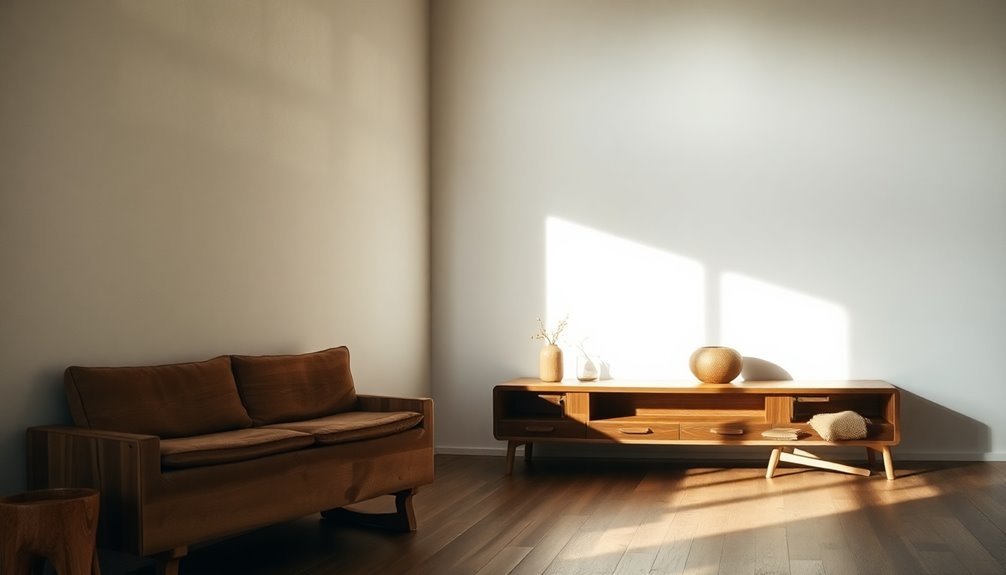Wabi-Sabi and Japandi share a love for simplicity, but they approach design differently. Wabi-Sabi celebrates the beauty of imperfection and the transient nature of objects, focusing on organic forms and intimate settings. In contrast, Japandi embraces minimalist functionality with clean lines and a neutral color palette, prioritizing practicality over decoration. Both styles use natural materials, but Wabi-Sabi leans towards rustic charm while Japandi retains a more refined look. Mixing these philosophies creates spaces that highlight imperfect beauty and serenity. If you're curious about how to incorporate these styles into your home, there's more to uncover.
Key Takeaways
- Wabi-Sabi celebrates imperfection and transience, while Japandi emphasizes minimalist functionality and clean lines.
- Wabi-Sabi incorporates organic, unstructured arrangements, contrasting with Japandi's focus on practical, refined designs.
- Both styles value natural materials, but Wabi-Sabi leans towards rustic elements, whereas Japandi prefers a more polished aesthetic.
- Wabi-Sabi fosters emotional connections through the stories of objects, while Japandi promotes calmness through simplicity and order.
- Mixing the two styles creates serene spaces that highlight imperfect beauty, blending warmth with minimalism.
Philosophy of Wabi-Sabi

The essence of Wabi-Sabi lies in its celebration of imperfection and transience. This philosophy invites you to appreciate the beauty of imperfection, embracing the natural aging process of objects and materials.
It emphasizes simplicity and naturalness, encouraging a mindful connection to the present moment. You'll find that Wabi-Sabi reveals the unique character of items often overlooked in a fast-paced world.
By focusing on authenticity, this aesthetic cultivates a deeper appreciation for life's fleeting moments. Originating in 16th-century Japan, Wabi-Sabi promotes intimacy through its acknowledgment of incompleteness and impermanence.
Engaging with this philosophy opens your eyes to the inherent beauty found in the flawed and weathered aspects of existence, transforming your perspective on everyday life.
Key Characteristics of Japandi

While exploring Japandi design, you'll notice its key characteristics emphasize a harmonious blend of minimalism and functionality. This style beautifully combines elements from both Japanese and Scandinavian aesthetics.
Here are four defining features of Japandi:
- Minimalist Design: Every element serves a practical purpose, avoiding unnecessary decoration.
- Natural Materials: Wood, rattan, and stone create a connection to nature and promote sustainability.
- Neutral Color Palette: Light woods paired with black accents maintain a serene atmosphere while providing visual interest.
- Acceptance of Imperfections: Drawing from Wabi-Sabi, Japandi embraces flaws and asymmetry, fostering a relaxed and harmonious living environment.
Together, these characteristics create spaces that prioritize spaciousness and the beauty of simplicity, reflecting a deep appreciation for the Japanese aesthetic.
Design Approaches and Space Utilization

Understanding the design approaches of Wabi-Sabi and Japandi reveals how each style utilizes space differently to create distinct atmospheres.
Wabi-Sabi embraces organic, unstructured arrangements that celebrate imperfections and natural materials, fostering a calming atmosphere that feels intimate and personal. This approach encourages you to connect with the past and the stories of your objects.
In contrast, Japandi prioritizes functionality and minimalist aesthetics, utilizing clean lines and thoughtfully selected items to maintain harmony and reduce visual clutter.
While both styles incorporate natural materials like wood and stone, Wabi-Sabi often leans towards rustic elements, whereas Japandi showcases a more refined, modern interpretation.
Together, these approaches create unique spaces that reflect different philosophies of beauty and utility.
Mixing Wabi-Sabi and Japandi

Mixing Wabi-Sabi and Japandi offers a fascinating way to create spaces that feel both grounded and serene.
By blending these styles, you can enjoy a unique aesthetic that highlights imperfect beauty while maintaining functionality.
Consider these tips for achieving harmony and balance:
- Use natural materials and neutral colors to create a cohesive look.
- Incorporate handcrafted objects that showcase rustic charm alongside sleek Japandi style.
- Embrace earthy tones to soften the minimalist approach of Japandi interiors.
- Add curves and textures from Wabi-Sabi to introduce warmth without overwhelming simplicity.
This combination will enhance your space, creating a sense of tranquility and inviting atmosphere that reflects both styles beautifully. Furthermore, combining these elements can also draw inspiration from traditional Indonesian style home decor, emphasizing the use of natural materials and cultural motifs.
Aesthetic and Emotional Connections

Aesthetic and emotional connections in design can profoundly impact how you experience your living space.
Wabi-Sabi invites you to embrace the beauty of imperfection, fostering emotional connections through unique stories behind each handcrafted item. This aesthetic philosophy celebrates natural materials, reminding you of life's transience.
In contrast, Japandi merges Japanese minimalism with Scandinavian functionality, creating serene environments that promote calmness and balance. Its clean lines and uncluttered aesthetic evoke feelings of mindfulness and well-being.
Both styles encourage introspection and connection—Wabi-Sabi through its appreciation of nature's flaws, and Japandi through its cozy, harmonious design.
Frequently Asked Questions
Are Japandi and Wabi-Sabi the Same?
No, Japandi and Wabi-Sabi aren't the same.
Japandi combines Japanese minimalism with Scandinavian functionality, focusing on clean lines and practicality.
In contrast, Wabi-Sabi celebrates the beauty of imperfection and transience, highlighting rustic forms and unique characteristics.
While both styles value natural materials and a connection to nature, Japandi emphasizes a harmonious aesthetic, whereas Wabi-Sabi embraces the stories behind flaws, creating a deeper emotional resonance in spaces.
What Is Wabi-Sabi in Zen?
Wabi-Sabi's like a gentle breeze, reminding you of life's fleeting beauty.
In Zen, it encourages you to embrace imperfections and the natural aging of things. You find peace in simplicity, appreciating the unique stories behind everyday objects.
This philosophy resonates with mindfulness, helping you accept the transient nature of life. By focusing on authenticity and harmony with nature, Wabi-Sabi allows you to cultivate tranquility and introspection in your surroundings.
What Is Similar to the Wabi-Sabi Style?
If you're drawn to Wabi-Sabi, you might also appreciate rustic design, which celebrates natural materials and a rugged aesthetic.
Minimalism shares Wabi-Sabi's love for simplicity and decluttering, creating serene spaces.
You'll find Scandinavian design appealing too, as it blends comfort with functionality and earthy tones.
Zen design emphasizes tranquility and mindfulness, much like Wabi-Sabi, while Bohemian style embraces individuality and imperfections, offering a personal touch to your decor.
What Is the Difference Between Modern and Wabi-Sabi?
Did you know that nearly 70% of people feel more relaxed in spaces with natural elements?
When you compare modern design to Wabi-Sabi, you'll see distinct differences. Modern style often favors sleek, polished finishes and uniformity, while Wabi-Sabi celebrates imperfections and aged beauty.
Instead of sterile environments, Wabi-Sabi invites warmth and authenticity through handcrafted pieces, muted tones, and an organic layout that embraces life's natural messiness, creating a more soothing atmosphere.
Conclusion
In exploring the differences between wabi-sabi and Japandi, you'll find a rich tapestry of philosophy and design that speaks to the soul. Like a gentle breeze rustling through leaves, both styles invite you to embrace imperfection and simplicity while creating harmonious spaces. By blending their unique qualities, you can cultivate an environment that resonates emotionally and visually, allowing tranquility and beauty to flourish in your home. Embrace these philosophies, and let them inspire your personal sanctuary.









